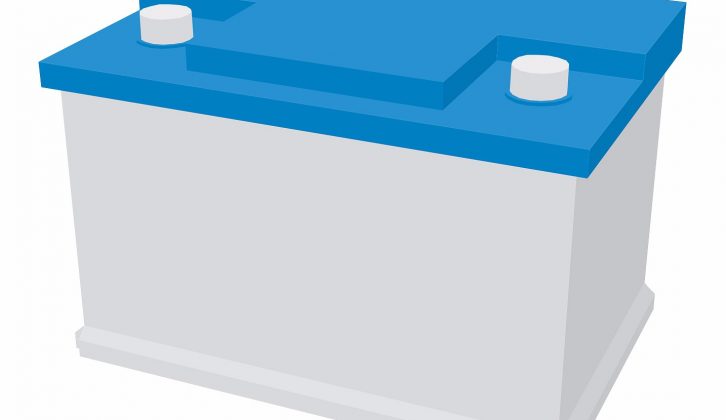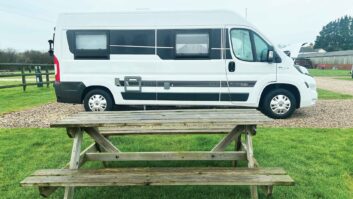A common issue for motorhome owners is battery life – not how many years it will last, but how many hours it will power devices for.
Most leisure batteries are the lead acid type and suffer a reduced lifespan if they are excessively discharged on a frequent basis – the rule of thumb is not to discharge beyond 50% regularly.
So how long should a leisure battery provide power? This depends how much current is drawn from it.
Capacity is measured in amp hours (Ah) and, in theory, a 100Ah battery should provide 1A for 100 hours or 100A for one hour – but sadly, it’s not that simple.
The 50% rule
First, you need to bear in mind the 50% rule – a 100Ah battery is only reliably good for 50Ah.
You also need to consider that the battery’s actual capacity will vary according to how much current is being drawn – the higher the current, the less the actual capacity will be. That 100Ah battery is looking pretty puny now.
One recent case in point was a bit of a head scratcher. The customers were new motorhome owners, who complained that their twin leisure batteries wouldn’t last more than a couple of hours when they were watching TV.
The batteries were new and had been tested and deemed good, and the charging systems were all functioning well, including the solar panel – so it was time for some testing.
Testing, testing
The setup was two 100Ah leisure batteries, and a 1000W inverter whose output is fed into the ’van’s 230V sockets via a selector switch in the wardrobe (enabling the entire 230V system to be powered from the mains hook-up, or just the sockets from the inverter).
The TV system was a roof-mounted auto satellite dish and a 12V monitor connected to a Sky receiver, powered from the inverter.
With it set up and running, and all the internal lighting switched on, the battery voltage was monitored, as well as the total current draw (around 11A).
After 45 minutes, the voltage was steady at 12.3V. So what was the problem?
The customer had explained that, during the installation of the dish, some wiring in the roof (the mains feed to the fridge) was damaged.
This was rewired with a new feed and the original feed disconnected to make it safe. Here was the clue.
The output from the inverter had been connected so it only fed the sockets, not the on-board charger or fridge. When the fridge was rewired, it was connected to the sockets’ circuit.
The fridge was an Auto Energy Selector (AES) model, so when the inverter was switched on, the fridge saw 230V and selected mains as the power source, but the power was coming from the batteries via the inverter.
So with the fridge on, the draw on the leisure batteries went from 11A to 28A.
Another problem with using the inverter to power the Sky box was interference on the TV screen, so my advice was to invest in a 12V TV with a built-in satellite receiver.
A quality 12V TV will reduce the current draw for the TV system from 5-6A to about 2A.
Keeping your fridge cool
Our own camper conversion (the Duchess) has been in regular use for almost two years now, but there are still details to be completed.
Earlier this year I (almost) finished the washroom/toilet area, built a large pan drawer under the fridge and fitted some LED lighting and a DAB radio by the bed.
One area of mild concern was the gas consumption of the large three-way AES fridge-freezer.
I’ve often seen forum comments about more efficient running after fitting ventilation fans behind fridges to improve airflow over the cooling unit, and I’ve installed a few for customers.
I decided to fit one to the Duchess, and I had an old 12V computer fan and a 12V adjustable temperature controller.
The controller can be programmed to switch a relay on and off at your chosen temperatures, so I set the ‘on’ to 25C and the ‘off’ to 20C, with the probe above the heat exchanger.
One nice feature is a digital display of the temperature measured at the remote probe. But how could I test whether it made a difference?
Measuring gas consumption
Measuring gas consumption is not easy, but I do have a temperature data logger, which can be set to record the temperature in its location.
Set to record at five-minute intervals, it was placed in the fridge and left to its own devices.
The fridge has been running for most of a week, on mains overnight in the workshop and gas during the day while outside, and a mixture of the fan on and off.
If the fan does aid cooling, I’d expect to see the temperature drop faster when it is running. Disappointingly, it doesn’t seem to have made any difference.
The fridge temperature control works really well, dropping to a low of 3C and a high of 6C, so a mean temperature of around 5C is being maintained on both power sources.
The cycle duration from 6C to 3C and back takes about one hour 50 minutes, meaning the burner or mains element is on for half that time.
To put it another way, it is running on a 50% duty cycle.
Oh well, at least the beer’s nicely chilled!
A keen motorcaravanner, Practical Motorhome’s technical expert Diamond Dave runs his own leisure vehicle workshop. Find out more at Dave Newell Leisure Vehicle Services.
How long should a leisure battery provide power?









